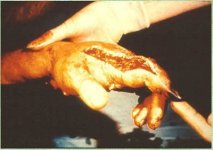Another similar injury.
Finger that has been lanced in attempt to save the finger and the hand. The injury was caused by a high - pressure injection of hydraulic fluid. If there is a pinhole leak in the hydraulic line and someone runs there hand along it, at 2000 psi, they can easily incur and injection of hydraulic fluid and may not even be aware that it happened until gangrene begins to set in. Use cardboard held above the line to check for leaks.
In addition, used hydraulic is very bad for the human body.
Independent testing revealed large amounts of visible masses. These masses were made up of metal particles, accumulated over time from wear, and soot-like carbon particles formed as the hydraulic oil broke down. Additionally, anti-wear additives in the oil changed form and released their component substances. Due to these breakdown processes and the accumulation of foreign particles, the waste hydraulic oil appeared visibly darker in color.
Specific contaminants identified by the independent laboratory include arsenic, lead, cadmium, chromium, nickel, zinc and other metals. Arsenic, cadmium, chromium and nickel are metals that can cause cancer. Leads propensity to produce a variety of adverse health effects has made this metal a particular focus in regulatory controls of chemical exposures.
Research regarding a number of the identified metals has documented their potential to increase susceptibility to pneumonia-like illnesses and other infections. Many of the same metals have been associated with allergic reactions and the progression of long-term autoimmune illnesses. Particulate matter, such as that found in the waste hydraulic oil, can trigger foreign body reactions that slow wound healing, and its petroleum components can cause irritation to the skin or other tissue.
